
Sailing Vessel Beruta Ship's Log
Noumea - Brisbane
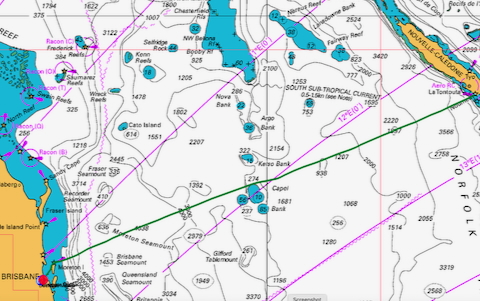
Monday, June 23, 2025
Finally, the wind started blowing toward Australia. Before this, I was wondering if I should head back to New Zealand. I even missed its beauty and subtropical climate a bit. In early June, it wouldn’t have been so bad to sail there. Winter storms start later.
But now, after a month in Nouméa, where I mostly studied the Brisbane job market and worked on programming my neural network-based chess engine, the wind became steadier, and it was time for the final passage.
Final—not forever, but for now, as I don’t plan further voyages any time soon. The thrill isn’t as strong anymore, so I need a break. Plus, money’s running out; time to get back to work.
Morning was spent on departure formalities. First, immigration—took 5 minutes since I’d filled out the form in advance. Then customs—20 minutes, as I had to fill out three pages: two for departure and one for duty-free diesel. The last stop was the port captain, who wasn’t in. When I called, he said he was dealing with a fire on a fishing vessel but would be back in half an hour. Nothing to do but wait, so I sat on the curb. Port staff noticed me, invited me to sit inside on a couch, but I preferred the fresh air. They decided not to make me wait too long and processed my departure clearance without the captain. It took about 30 minutes total. The captain’s assistant wasn’t in a rush and wanted to chat about this and that.
Last stop was Auchan. By 10 AM, I returned the keys for the toilet, shower, and gate to my berth at the marina office. I’d settled the mooring fees earlier that morning.
All that was left was to prepare and stop at the fuel dock. At 11:30, I cast off from my pier and headed to the fuel dock at the marina exit. I still had half a tank, so I filled only 9 jerry cans.
At noon local time (UTC+11), I left Moselle Marina, stowed the mooring lines and fenders, set a third of the main in the shadow of the hill, and sailed toward the bay’s exit.
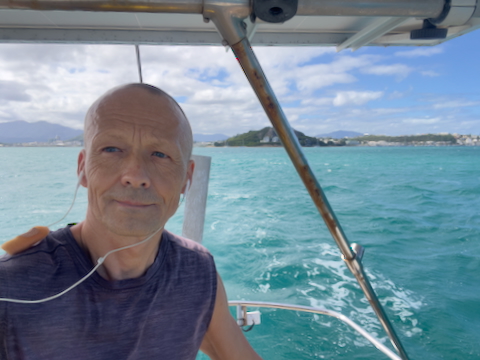
The barrier reef is 6 miles away. It’s blowing strong: 25-30 knots. An hour and a half later, I cleared the reef. On the way, a large yacht and a fishing vessel overtook me. Seems I wasn’t the only one waiting for weather. A French crew was also processing their departure for Australia, but they planned to leave the next day.
Once I got some distance from New Caledonia’s shores, the wind seemed to ease slightly. The forecast predicted strengthening from 5 PM until morning. Thinking it might have already peaked, I added the jib to the triple-reefed main. But the wind hadn’t even started to strengthen! I soon had to lower the jib and raise the storm jib instead. That setup didn’t last long either. After dark, gusts from nowhere, under a clear starry sky, pushed the yacht upwind, and the autopilot panicked—it couldn’t cope and froze. This time, I had to lower the main, even after easing the jib halyard, which didn’t help. So, I reinstated the storm jib and stowed the main.
Even under just the storm jib, speed was 5-6 knots. The wind was unsteady, though. At times, it blew so hard everything whistled; other times, it eased, and speed dropped to 4-5 knots.
It’s chilly at night, especially in the wind—almost cold. The tropics are over. Subtropical winter has begun.
Tuesday, June 24, 2025
As you can tell, the night was restless. Barely slept.
Morning brought clouds and light rain. The wind eased and shifted. I raised a third of the main, and the storm jib ended up in its shadow, so I lowered it. The clouds caused the wind to shift, and I changed tacks, gybing. To justify myself, with almost no sun and batteries needing a charge, I started the engine.
Made syrniki for breakfast.
Waiting for Starlink. It’s been over an hour unable to get GPS coordinates, rebooting every 30 minutes. Unreal. Maybe I got a defective unit? Finally! An hour and a half to get coordinates! Can you imagine a GPS like that?
At 10 AM, I shook out the second reefs on the main. Speed around 6 knots. Covered 127 miles in the last 24 hours.
Wednesday, June 25, 2025
Last night, the wind gradually eased. At 3 AM, it started raining, and the wind shifted to a light headwind for a couple of hours. Started the engine.
At dawn, a broad reach picked up again, port tack. Stowed the storm jib and raised the regular jib. But the wind died quickly. Clouds with rain come and go, but no squalls. This is the so-called warm sector, though it’s quite cool. Tomorrow, a weak cold front is expected. A cyclone is passing south of Australia.
Today, Starlink got GPS coordinates in 32 minutes—progress compared to yesterday!
After breakfast, I poured three jerry cans of diesel into the fuel tank, running it through a 30-micron Racor filter, the same as the engine’s pre-filter. The final filter is 10 microns. This system for handling diesel in the tropics works very well. First, you don’t pour fuel directly into the tank, reducing the risk of introducing dirt. In sketchy places, I even filter fuel into the cans through a funnel with a filter because I don’t want dirt in them either. Second, I add biocide to the cans to prevent bacteria from growing and feeding on the diesel. Third, as mentioned, the fuel from the cans is pre-filtered before the tank. Any water is removed by the Racor filter. A mesh screen on the tank’s pickup tube prevents large debris from clogging the tube or fuel line. Early in my yachting life, clogged lines or filters at the worst times—like entering a marina or navigating a narrow passage with reefs and strong winds—were a big issue. I also have two pre-filters on the engine; if one clogs, I can switch to the backup in seconds. The headaches from Biruta’s early years disappeared after I cut a hole in the fuel tank, cleaned its first chamber (the other two seem nearly impossible to access), and installed the mesh screen. The backup filter, ready to switch anytime, ensures safety and peace of mind.
Another undeniable advantage is that diesel is pumped from the cans through a hose with a small pump. Before, pouring directly from cans into the tank was a struggle. On deck, there’s a risk of a wave splashing seawater into the tank. That happened when Anton and I sailed from New Zealand to Fiji, and we had to pump water out from the tank’s bottom. Another risk, especially in rough seas, is spilling diesel on the deck or into the sea. The same applies when pouring inside the engine compartment, where space is tight and it’s awkward.
I’m motoring almost constantly; the wind is weak. Covered 131 miles in the last 24 hours.
In the evening, the wind shifted, so I lowered the jib and sheeted the main in tight. Speed dropped to 4-4.5 knots.
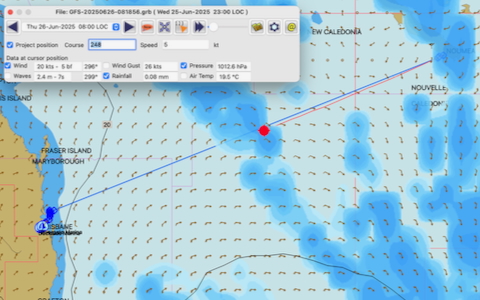
Thursday, June 26, 2025
This morning, a light wind still blows sharply on the starboard side. I haven’t passed the front yet, though the weather map says I’m in it. The wind should shift to a port tack after lunch and gradually back. Maybe by evening, I can raise the jib. Friday should bring a beam reach, transitioning to a broad reach.
Starlink took 40 minutes to acquire GPS coordinates.
Yesterday, my chess engine finally worked properly. Played a few games against it and lost them all! Well, this version isn’t entirely mine. I added a trained NNUE neural network, which Stockfish uses for position evaluation. The difference is that Stockfish uses an alpha-beta minimax algorithm for search, while I use Monte Carlo tree search. Now, I want to finish implementing the UCI protocol to compare my engine with Stockfish to see which algorithm is better. Grok 3 says alpha-beta is faster because bad moves are pruned early through proper move ordering and heuristics, significantly reducing the search space. On the other hand, it acknowledged the originality of my modified Monte Carlo algorithm, where moves aren’t selected randomly but based on probabilities calculated after evaluating each move with the NNUE network. My approach’s advantage is controlling the balance between exploiting known moves and exploring unconventional ones. Stockfish lacks this flexibility, choosing only reliable moves. So, my match against it should be interesting if played at, say, 3-5 seconds per move, not prioritizing speed. I also need to add multithreading with OpenMP to search the tree in parallel on multiple CPU cores.
The front passed almost unnoticed, without rain. By evening, the temperature dropped another two degrees. 23°C in the cabin, 20°C overboard. But the wind picked up.
I delayed raising the storm jib as long as possible. On a close-hauled course, Beruta accelerates easily and then does a “springboard jump.” She usually lands loudly and painfully, smashing into the ocean’s surface, shaking bulkheads and cracking the mast step beam. Been there, done that, more than once.
I sailed with a double-reefed main, and since on a close-hauled course with this sail setup, the yacht would just drift or move forward with heavy leeway and a speed of no more than 3 knots, I assisted with the engine at low RPMs. Managed to maintain about 5 knots. With a jib, even a storm one, speed would’ve been over 6 knots. The wind, as usual, wasn’t the forecasted 19 knots but 25-30. The waves were 3 meters with a 3-second period—very steep.
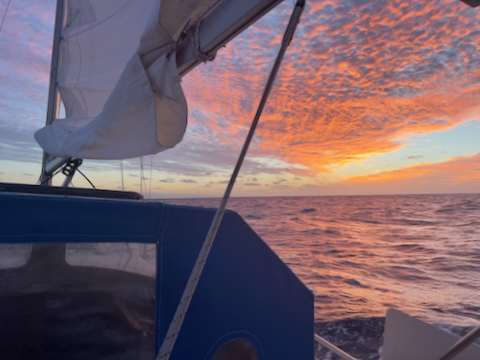
Friday, June 27, 2025
Early morning—well, 7 hours before dawn, or to be precise, at midnight local time—I shut off the engine, put on a rubberized raincoat, took third reefs in the main, and raised the storm jib. Speed, as expected, exceeded 6 knots. But by then, the wind had backed slightly, no longer a tight close-hauled course, and the waves weren’t directly on the bow. Still, the number of drops—where your insides freeze, or something in your stomach gives way—was enough to send adrenaline levels through the roof. That extraordinary weightless feeling when you know you’re airborne, but when, where, and how you’ll land is a mystery. Often, it wasn’t as bad as expected. But sometimes, when you’ve dozed off, it hits you full force! First, a plywood board I use as a lap dining table flew off the ceiling. Then, from the opposite side’s shelves, a bunch of provisions came crashing down: cookie boxes, cereal, and something else. All in all, quite a night.
At dawn, it was still blowing hard! It started easing after lunch. Speed dropped to 5 knots. Seemed too slow. Shook out one reef on the main—didn’t help much. Swapped the storm jib for the regular one—perfect! Speed at 6 knots, almost a beam reach. 287 miles left to the Australian coast. 333 to Brisbane. Should be there by Monday.
I’ll need to clear in at Rivergate Marina, near the first bridge over the Brisbane River. They have a customs dock where you can stay free for 4 hours. Then I plan to move to Dockside Marina, in central Brisbane, 6 more miles upriver. You can live aboard there for about $1,600 a month. I think that’s cheaper than renting an apartment. I haven’t checked if living aboard is allowed at Rivergate. It’s probably cheaper since it’s farther from the city center. I need to sort out work first, then choose a marina. If I can find a fully remote job, my options expand. Living on the river is its own challenge—the yacht will get fouled in days.
The catch is customs clearance for the yacht. First, I’ll need to get its market value assessed. Then, they add the cost of shipping from the purchase location—New Bedford, USA. That’s calculated somewhat arbitrarily, and it’s unclear who does it. Then, a 5% customs duty is applied to the total, plus, I think, another 5% purchase tax. The total could be $5,000 or more. Customs brokers in Brisbane charge about $1,000 for their services, and I found only two. Plus, the surveyor charges roughly the same. It’s expensive to live, work, and travel in Australia. But if you see it as the cost of another citizenship, it’s bearable.
Another issue is that after the survey, you get two months to pay. Where the yacht can stay during those two months is unclear. From what I understand, it’s up to the customs officers. They might not allow me to move to another marina until I’ve paid.
In short, more questions than answers. And it’s frustrating—such seemingly simple issues...
Waiting for Starlink. It’s been over an hour unable to get GPS coordinates! It’s eating 42 amps of solar power—or diesel if the sun’s not enough. Without coordinates, it can’t connect to the internet. I hope Amazon’s satellite system will be better. Finally! 1 hour 10 minutes!
In my excitement, I forgot to download the latest weather forecast. By evening, it unexpectedly started blowing hard, more from the bow than the stern. It was supposed to be a broad reach, or at least a beam reach, but I had to sheet the sails in tight and assist with the engine because the wind would either die completely or gust from under a cloud, heeling the yacht heavily to starboard. After waiting another hour for internet, while pouring four jerry cans of fuel into the tank—now it’s full, with two cans in reserve—I downloaded a new GRIB file. Nothing had really changed in it. That’s the unstable weather here.
On Monday, a cyclone is forming off Queensland’s coast, so I need to hurry. There’s enough fuel to motor the whole way if needed. Decided not to shut off the engine—it adds at least one knot at low RPMs. The thing is, if I don’t rush, I’ll reach Moreton Island on Sunday night into Monday, when the weather starts deteriorating. Tacking at night in bad weather among shoals isn’t appealing. I’d prefer to reach the river before dark. The nights are pitch black now; the moon sets with the sun. Maybe the river will be better lit with shore lights? I think it’s fine if I arrive at the customs dock at night. Worst case, I can probably anchor. I saw boats anchored along the riverbank in Google images.
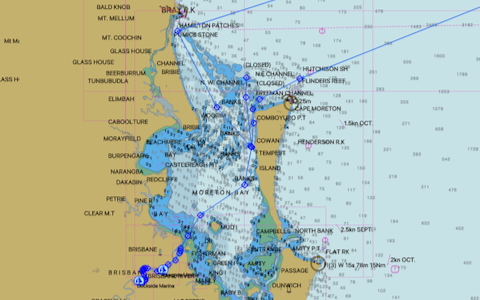
Saturday, June 28, 2025
This morning, I checked the tide times for Brisbane. It’s looking good. Low tide on Sunday at 6:54 AM (+0.61 m), high tide at 12:24 PM—this is Brisbane time, an hour behind my local time. If I reach Cape Moreton by 1:30 PM, I can skirt the island at high water (+1.78 m), cutting the route by at least 20 miles. That’s a significant time saving—at least 4 hours. The next low tide is at 6:08 PM (+0.59 m), and high tide at 12:39 AM (+2.41 m). It’d be ideal to reach the marina upriver with that big high tide.
On the tide website willyweather.com.au, the homepage links to an article about this fearsome cyclone threatening much of Australia’s east coast from Sydney to Brisbane next week, with strong gusty winds, heavy rain, flooding, waves up to 10 meters, coastal erosion, and more. They say it could be the worst in three years. I’m already seeing its early signs: isolated showers along Queensland’s coast. This is the warm, humid air coming from the north—warm, relatively speaking. These air masses will merge with a cold cyclone from southern Australia on Monday, forming a so-called cyclone bomb, where atmospheric pressure drops sharply in a short time. They note that such cyclones are hard to predict accurately, and small forecast errors could lead to big problems for Australia’s population. Specifically, they mention the cyclone’s distance from the coast—the closer, the worse, obviously.
In short, I’m hurrying for a reason. It’d be bad if they got the timing of its formation wrong.
Chess news: my engine lost several games in a row to Stockfish, playing both black and white, even with a 1:10 time handicap—one second per move for Stockfish, 10 for mine. Honestly, I thought better of it after reviewing the games. It seemed to have played much better against me. There’s still work to do. It’d be too bold to think my engine could beat the world’s strongest chess engine, unless we’re talking about the debated match with AlphaZero, where I think AlphaZero had a computational power advantage for its neural network to function properly.
I take back my words. Found bugs in the chess engine—so we’ll see who beats who! Out of modesty, I’d settle for a draw.
In the evening, I poured another jerry can of diesel into the tank, just in case, to avoid dealing with it in bad weather.
Switched to Brisbane time (UTC+10), setting the clock back one hour.
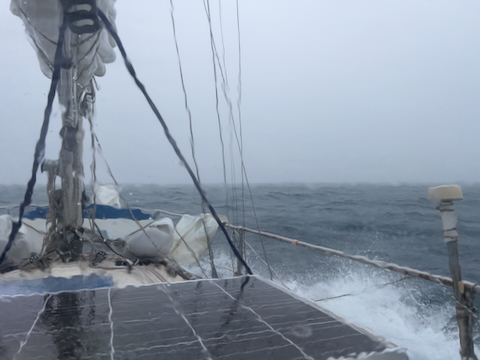
Sunday, June 29, 2025
The night passed without drama. Some traffic appeared, mostly with AIS, but some without, so I got up a few times to check around. In the morning, I had to steer around a fishing vessel—it had the double right of way of being fishing but also being on my starboard side.
At 8:30 AM local time, Cape Moreton peeked through the clouds. Then the rain started. Visibility dropped significantly. Plus, a headwind kicked up—not strong, but annoying, especially since it wasn’t in the forecast. To maintain 5 knots, I increased engine RPMs.
Australia’s greeting me for the second time with weather that makes it seem like it’s not happy to see me. I’m so excited to be here, but it doesn’t feel mutual.
The waves are quite steep. I even wondered if it’s worth risking the Newman Passage, with its 2.5-meter depth. The tide will add at least a meter, but what if the chart hasn’t been updated recently? It warns to be vigilant—sandbanks do shift.
After some rational thought, weighing pros and cons, I concluded the risk isn’t too high: the wind is head-on—a plus; it’s easy to get off a shoal; the tide is rising—another plus; I can always wait for more water. The only downside is the waves, which could bash the yacht against hard sand. I didn’t want to lose precious time entering Moreton Bay via the main deepwater channel.
My fears were unfounded. I found a spot in the Newman Passage marked at 5 meters, above the 2.5-meter mark. And it was true—never less than 5 meters under the keel.
In the bay, the wind stayed head-on the whole way. The waves were small but frequent. Plus, a countercurrent from the ebb tide starting at 12:30 PM. I had to keep the engine near full throttle to maintain 5 knots. It rained constantly, and visibility was awful. Plus, it’s cold.
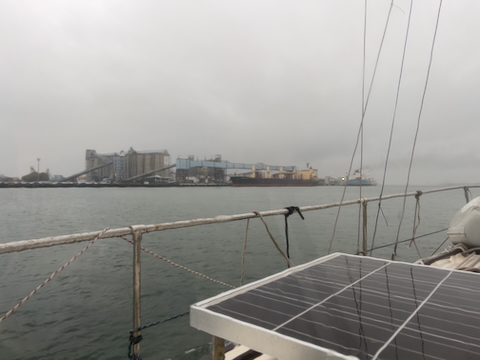
I reached the mouth of the Brisbane River around 3 PM. Two hours until sunset. Ten miles to Rivergate Marina. In the river, the ebb tide and river current dropped my speed to 4 knots. I’d arrive after dark, and visibility was already bad due to constant rain.
There’s the bridge. Rivergate Marina to port. The customs dock, E, has a huge ferry on it. No other spots. Fine, I’ll tie up at the fuel dock for now. Then I see people waving flashlights from the fuel dock. I approach—a man and a woman. They tell me to go to berth A12. I say I need to clear in. Turns out, they’re from the Australian Border Force (ABF)—customs, immigration, and border control in one. They tracked my arrival via AIS and came to meet me! How great is that? I was going to email them about my arrival, assuming they’d be off for the weekend and would come tomorrow. They work until 11 PM, even on weekends. They’d sent me an email saying dock E was occupied and to head to A12. I’d only checked my email early morning, so I hadn’t seen it. Big thanks to them for their care and foresight.
So, I tied up at A12. If I’d printed and filled out the forms they emailed, clearance would’ve been much faster. But it went smoothly anyway. They didn’t even search the yacht, unlike in Darwin. They allowed Beruta to stay in Australia for one year, extendable to three. After that, I’ll need to either import the yacht or leave. The special visa for New Zealanders is virtual—it exists but doesn’t. I can work as a New Zealander. I just need to keep ABF informed about the boat because it is on the control permit: report Beruta’s location every three months and if I leave the yacht temporarily.
Tomorrow morning, biosecurity will come. Gotta eat those apples quick!
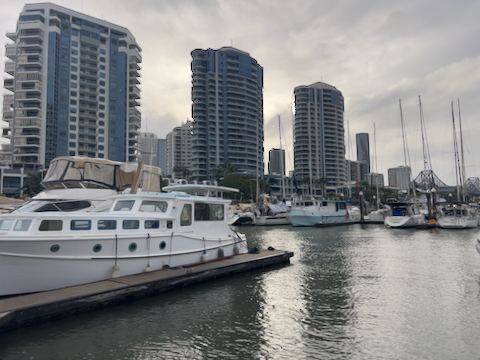
Monday, June 30, 2025
The biosecurity inspector arrived around 9 AM. By then, I’d already had breakfast and laid out all the food in plain sight to speed up the process and save some money.
It cost about $500 AUD, a bit cheaper than last time. Had to throw out only a can of rice. I was eating the apples during the inspection. The inspector had no other issues. Everything went smoothly in a friendly atmosphere.
The marina charged me $5 for waste disposal and $79 for the overnight stay. They helped me contact Dockside Marina. Ken, the marina manager, said I could come over and asked me to temporarily tie up at the first outer dock.
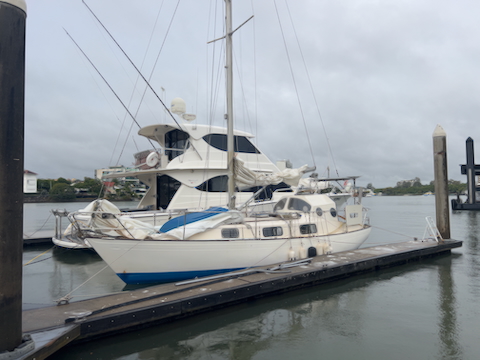
This saved me a 1.5-hour bike ride in the rain to a mall for a SIM card, though I ended up buying an e-SIM online. So, I headed straight to Dockside Marina, 6 miles upriver. The tide gave me a following current, so I reached the marina in an hour. I tied up and went looking for the office, which, as it turned out, barely exists. As I was returning to the yacht, Ken met me at the pier entrance. He helped me move to another temporary berth, meant for 15-meter yachts. My 10-meter berth should free up soon. Ken gave me keys for the toilet, shower, and pier gate, took my credit card details, and we parted ways. Later, I emailed him the signed berth rental contract, yacht insurance and registration, a copy of my passport, and references from Hobsonville marina, where I lived in Auckland.
And with that, I can wrap up my account of the passage from Nouméa to Brisbane. Until the next voyage!
First pictures from Brisbane are on Google Photos.

